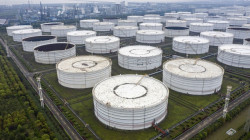Oil prices rise as U.S. strategic reserve purchases boost

Shafaq News/ On Monday, oil prices edged higher, gains for a second consecutive session. U.S. initiatives to replenish strategic reserves offered support, though concerns about crude oversupply and softer fuel demand growth in the coming year persisted.
Brent crude futures increased by 0.6% or 48 cents to reach $76.32 a barrel by 0406 GMT, while U.S. West Texas Intermediate crude futures rose to $71.61 a barrel, up 0.5% or 38 cents.
Both contracts witnessed over 2% jumps on Friday but recorded their seventh consecutive week of declines, marking their longest streak since 2018, due to lingering oversupply concerns.
The recent dip in prices prompted the U.S. to seek up to 3 million barrels of crude for the Strategic Petroleum Reserve (SPR) for delivery in March 2024, providing additional support.
"We know the Biden Administration is in the market looking to refill the SPR, which will provide support," noted IG analyst Tony Sycamore, highlighting technical chart indicators as another factor supporting prices.
Despite OPEC+ pledging a 2.2 million barrels per day (bpd) production cut in the first quarter, investor skepticism about an actual drop in supply persists. Output growth in non-OPEC countries is expected to contribute to excess supply next year.
RBC Capital Markets anticipates stock draws of 700,000 bpd in the first half but only 140,000 bpd for the full year. RBC analysts emphasized that prices will likely remain volatile and directionless until clear data points on voluntary output cuts emerge.
The latest consumer price index data from China, the world's leading oil importer, revealed rising deflationary pressures amid weak domestic demand, casting doubt on the country's economic recovery. Chinese officials pledged on Friday to boost domestic demand and enhance the economic recovery in 2024.
This week, investors are closely monitoring meetings at five central banks, including the Federal Reserve, for guidance on interest rate policies, along with U.S. inflation data, to assess their impact on the global economy and oil demand.





